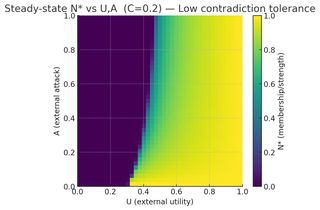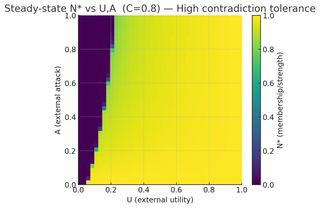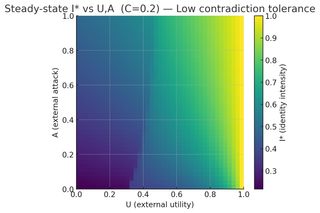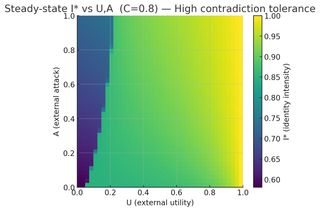Important disclaimer for just-in-case purposes, you know: below is interpretive analysis. Sources are linked, errors are mine.
War has changed. Ron Perlman was half right when he talked about war never changing—the human drive for power and resources remains constant. But Hideo Kojima was onto something deeper when he flipped that line using David Hayter's voice: war has changed, fundamentally. The battles that determine global power no longer happen just on territorial battlefields—they happen inside information systems, inside the belief structures that shape how entire populations understand reality. The most successful military operation of the 21st century to date isn't happening in Ukraine or the perpetually troubled areas of the Middle East. It's happening inside American political networks and social media, and most people don't even recognize it as warfare.
Beneath the slogans and rallies of what appears to be a populist movement is a well-structured network—a coalition army with fortified positions, interlocking alliances, and shared supply lines of funding, narrative, and legitimacy. This is why MAGA remains resilient despite constant attacks, and why any effort to counter it needs to focus less on the figurehead and more on the network's logistics.
1. The Real MAGA Network — Beyond a Trump-Centric Model #
MAGA is not structurally a cult of personality. The Trump cult exists and has real power, but it operates within—and is constrained by—an underlying coalition of aligned interests that would persist without him.
This coalition includes distinct infrastructure components: the Policy Engine (Heritage Foundation/Project 2025), Technolibertarian Capital (Musk/Thiel ecosystem), Foreign Influence channels, and Alt-Media networks. These create the connective tissue that holds otherwise disparate groups together through shared logistics: funding pipelines, narrative amplification systems, and policy coordination mechanisms that align elite interests across multiple sectors.
Evidence: When Infrastructure Overrules the Leader #
Trump's tech and crypto positions show the coalition constraining the persona. In July 2019, he unleashed what Harvard Law called a "thunderous tweet-storm" against cryptocurrencies, declaring: "I am not a fan of Bitcoin and other Cryptocurrencies, which are not money, and whose value is highly volatile and based on thin air" (Harvard Law School Forum). Fast-forward to 2025: he's establishing a Strategic Bitcoin Reserve and appointing David Sacks as AI and crypto tsar. This reads less like a personal evolution, and more like infrastructure alignment.
Similarly, Trump's complete reversal on TikTok shows coalition interests overriding his stated national security concerns. In 2020, he signed executive orders to ban TikTok as a Chinese surveillance threat, forcing ByteDance to sell or face removal from U.S. app stores. By 2024, he opposed the TikTok ban after striking a "rapprochement" with the Club for Growth, whose benefactor billionaire Jeff Yass owns 15% of ByteDance through his investment company (Time, Politico). The same national security threat he once called urgent became acceptable once a coalition stakeholder's $15 billion stake was on the line. The Club for Growth even hired Trump loyalist Kellyanne Conway to lobby against the ban.
Trump adapts his positions to serve coalition logistics, demonstrating that even the most visible leader operates within structural constraints.
Network Analysis: Mapping the Structure #
To test this structural hypothesis, I modeled the coalition as a weighted network with 12 key nodes across infrastructure and belief layers. This is a stylized, back-of-the-napkin analysis—edge weights reflect my assessment of relationship strength based on public reporting, funding flows, and narrative coordination patterns, not rigorous measurement. The goal is exploratory: to see whether network structure might explain both MAGA's resilience and Trump's constraints.
graph TD
subgraph SUBSTRATE ["Substrate: Infrastructure & Enablers"]
TP["Trump<br/>(Persona)"]
PE["Policy Engine<br/>(Heritage/Project 2025)"]
TC["Tech Capital<br/>(Thielverse/Musk)"]
FI["Foreign Influence<br/>(Russia-linked)"]
AM["Alt-Media<br/>(Narrative Amplification)"]
end
subgraph SUBSTANCE ["Substance: Beliefs & Ideology"]
AF["America First"]
EI["Election Integrity"]
CR["Cultural Restoration"]
AP["Anti-Elite Populism"]
EN["Economic Nationalism"]
LO["Law & Order"]
PS["Patriotic Symbolism"]
end
%% Persona connections
TP -.-|1.0| AF
TP -.-|1.0| EI
TP -.-|0.9| CR
TP -.-|0.9| AP
%% High-weight Foreign Influence connections
FI ===|0.90| AM
FI ===|0.90| EI
FI ===|0.85| TC
FI ---|0.75| AP
FI ---|0.55| PE
%% Alt-Media connections
AM ===|0.90| AP
AM ---|0.75| PS
AM ---|0.75| PE
%% Policy Engine connections
PE ---|0.8| AF
PE ---|0.85| EN
PE ---|0.7| LO
PE ---|0.6| TC
%% Tech Capital connections
TC ---|0.6| AF
TC ---|0.7| AP
TC ---|0.75| EN
%% Core belief connections
AF ---|0.9| EN
CR ---|0.8| PS
CR ---|0.75| LO
EI ---|0.85| AP
%% Bridge belief connections
AP ---|0.8| PS
EN ---|0.7| LO
%% Styling
classDef infrastructure stroke-width:3px
classDef persona stroke-width:2px
classDef coreBeliefs stroke-width:2px
classDef bridgeBeliefs stroke-width:2px
class TP persona
class PE,TC,FI,AM infrastructure
class AF,EI,CR coreBeliefs
class AP,EN,LO,PS bridgeBeliefs
The Policy Engine (Heritage Foundation/Project 2025) appears as the main broker, connecting different coalition factions. But examining the coalition's behavior suggests Foreign Influence operates differently—rather than brokering between groups, it appears to directly shape the amplification systems that all factions rely on for information and narrative framing.
These amplification systems are the Tech Capital platforms (like X/Twitter) and Alt-Media channels that control how information flows through the coalition. Rather than having to convince each faction separately, Foreign Influence can shape the information environment that all factions consume—the platforms they use, the media they trust, the think tank analysis they cite.
This structure would explain the coalition's coordinated positions on issues that serve foreign strategic interests: crypto legitimization, fossil fuel dependence, reduced regulatory oversight. Foreign Influence doesn't need to broker between factions if it can influence the Tech Capital platforms and Alt-Media channels that shape how all coalition members understand these issues. Trump, despite his visibility, operates more as a product of this information ecosystem than its controller—as shown by his reversals on crypto and TikTok when coalition pressures shifted.
This is state capture in action—not direct foreign control, but aligned interests where foreign oligarchs, domestic tech billionaires, and policy apparatus coordinate to shape government decision-making in their favor. The coalition structure creates overlapping incentives for the same outcomes: reduced financial transparency, weakened regulatory oversight, and narrative control that serves oligarchic interests whether foreign or domestic.
2. The Foreign Influence Spine #
Consider how a fandom works: a creator develops a fictional universe, and fans become so invested they dedicate enormous time, money, and emotional energy to it. They create fan art, attend conventions, defend the franchise online, and organize their social lives around it. The information system (the fictional universe) achieves cognitive dominance over its hosts (the fans), who allocate substantial resources to maintaining it while exhibiting fierce protective reactions when it's criticized. What started as someone else's creation has become central to the fans' identity.
Now imagine if you could engineer this process for political ends. Instead of a fictional universe, you design information systems around oligarchic priorities, anti-democratic frameworks, and foreign strategic objectives. Instead of targeting random fans, you target elite networks with access to capital, media platforms, and policy-making apparatus. The Bio-Informational Complex (BIC) that emerges operates exactly like a fandom — but instead of propagating fictional narratives, it propagates political positions that serve foreign interests.
This is how Foreign Influence operates as a BIC. The foreign information system (pro-Russian narratives, anti-regulatory frameworks, oligarchic priorities) has achieved cognitive dominance over key domestic hosts (Tech Capital, Alt-Media, Policy Factories), who now allocate substantial resources to maintaining and propagating these information systems while exhibiting protective reactions when challenged. The hosts aren't consciously serving foreign masters — they've internalized foreign information systems as their own authentic beliefs, just like devoted fans who genuinely believe their fictional universe represents profound truths about life.
Foreign Influence operates by attaching to elite-adjacent conduits in venture, media, and communications, where capital, access, and narrative can couple. Family ties to sanctioned elites are high-leverage attachment points because they combine social trust, jurisdictional complexity, and plausible deniability—precisely the features that make suppression slow and detection noisy.
The Alt-Media ecosystem exemplifies this narrative laundering process through both high-profile interviews and systematic operations. When Tucker Carlson traveled to Moscow for an exclusive Putin interview in February 2024, he framed it as addressing American audiences who "are not informed" about Ukraine, claiming Western media only provided "fawning pep sessions" with Zelensky rather than "journalism" (BBC). More systematically, According to U.S. prosecutors, RT—via intermediaries—directed roughly $10M to Tenet Media to fund prominent right-wing influencers including Tim Pool, Dave Rubin, and Benny Johnson—whose combined channels have over 14 million subscribers and followers (AP News). While these influencers claimed to be victims when the operation was exposed, their content consistently amplified Russia-friendly narratives to millions of Americans who trusted them as authentic conservative voices—regardless of whether the influencers knew the funding source.
Policy factories provide ideological cover by framing foreign-aligned positions as legitimate American strategic thinking. Heritage Foundation's "Chinese Handcuffs" series, for example, advocates against green energy transition and for maximizing U.S. fossil fuel dependence, arguing that renewable energy makes America vulnerable to Chinese influence (Heritage Foundation). While framed as anti-China policy, these positions serve Russian energy export interests perfectly. The recent $750 billion US-EU fossil fuel deal demonstrates this dynamic: by locking Europe into continued fossil fuel dependence rather than renewable development, such policies maintain global demand for energy markets where Russia remains a key player despite sanctions (Deutsche Welle). Heritage's advocacy against renewables directly supports this outcome by preventing the energy independence that would undermine Russian leverage.
Consider this traceable pathway: Russian oligarchs Petr Aven and Vadim Moshkovich (both sanctioned for their ties to the Russian state) have sons—Denis Aven and Jack Moshkovich—who work at venture firm 8VC. That same 8VC was listed in US District Court filings as an entity involved in financing Elon Musk's $44 billion acquisition of Twitter (X) via X Holdings Corp. The pathway runs: Russian state → sanctioned oligarchs → their sons at 8VC → Twitter acquisition financing → control of a major information platform. While both reports note there is no indication the sanctioned fathers have financial ties to 8VC, the structural relationship creates a plausible influence conduit (Deutsche Welle; Forbes).
This topology exemplifies why US counterintelligence flags such relationships as elevated-risk surfaces for attempted influence or data access—not because of proven malfeasance, but because the structural setup matches known foreign influence tradecraft. A rational adversary would attempt to instrument such ties, making them worth monitoring regardless of current evidence of misuse. While 8VC's leadership has publicly stated it maintains a strict compliance framework and has not taken money from the fathers or their associates, such assurances are precisely what one would expect from any entity operating in this space, regardless of actual compliance (Deutsche Welle; Forbes).
The concern is structural, not conspiratorial: when the same network that could channel foreign state influence also helps finance control of major information infrastructure, you have a plausible pathway for narrative manipulation at scale. The operational pattern matches known FI tradecraft: elite conduits → platform control → information dominance → grassroots narrative adoption under in-group legitimacy. It enjoys narrative dominance when it is embedded in the same nodes that control in-group discourse.
Trump's recent establishment of a Strategic Bitcoin Reserve further erodes traditional financial monitoring systems that could detect foreign influence flows. By legitimizing cryptocurrency at the highest levels of government—creating what David Sacks calls "a digital Fort Knox"—the administration undermines anti-money laundering (AML) frameworks that rely on traditional banking transparency. When the same government that should be monitoring suspicious foreign capital flows instead champions the very asset class that enables circumvention of those controls, it creates a policy environment where foreign influence operations can operate with reduced detection risk (BBC). This alignment between crypto legitimization and reduced financial transparency creates structural advantages for the same networks described above.
3. Why MAGA Is Antifragile #
The Foreign Influence BIC exhibits classic antifragile properties—it grows stronger under stress rather than merely surviving it. This isn't accidental; it's the predictable result of a high-contradiction-tolerance information system that has achieved cognitive dominance over its host networks.
These dynamics follow predictable mathematical patterns. The phase diagrams below show how fragile and anti-fragile information systems behave differently under stress—they're not calibrated to MAGA specifically, but demonstrate the theoretical patterns that explain how some belief systems collapse under pressure while others grow stronger.
Contradiction Tolerance as a Defensive Mechanism #
Traditional political movements depend on delivering utility—better policies, improved outcomes, fulfilled promises. The Foreign Influence BIC operates differently. It maintains strength through identity mechanisms rather than performance, converting contradictions into solidarity rather than allowing them to erode support. When Trump reverses positions on crypto or TikTok, the network doesn't fracture—it reframes these reversals as strategic flexibility or evidence of Trump "learning" and "growing."
This high contradiction tolerance (C) means the system can absorb massive discrepancies between promised and delivered utility without losing membership strength. The phase diagrams below show how this works: once C exceeds a critical threshold, external attacks actually increase both identity intensity and membership commitment rather than weakening them.

In conventional political movements (low contradiction tolerance), the left side of this diagram shows the expected pattern: when external utility (U) is low—when policies fail, promises aren't kept, or performance disappoints—membership strength (N*) drops toward zero. The dark purple zones show political death: high attack intensity combined with low utility delivery creates conditions where movements simply collapse.

The Foreign Influence BIC operates in a completely different regime. Even when external utility approaches zero (left side of the diagram), membership strength remains high (bright yellow zones). Most remarkably, increasing attack intensity (moving up the Y-axis) actually increases membership strength rather than decreasing it. This is the mathematical signature of antifragility: the system draws energy from stress rather than being depleted by it.
The Attack-to-Cohesion Conversion #
External criticism triggers what the model identifies as the "rally around the flag" effect—attacks get converted into identity strengthening rather than doubt. Each investigation, each media criticism, each academic analysis becomes evidence of persecution, which reinforces the narrative that mainstream institutions are corrupt and hostile. The Alt-Media amplification systems we identified transform external attacks into internal validation.

For normal political movements, identity intensity (I*) follows intuitive patterns. When utility is low and attacks are high (upper left corner), identity weakens and eventually fragments. People lose faith when the movement fails to deliver and faces sustained criticism. The dark zones represent identity collapse—supporters become disillusioned and drift away.

The Foreign Influence BIC shows the inverse pattern. The bright yellow zones in the upper portions reveal that attacks actually strengthen identity intensity rather than weakening it. This creates a feedback loop: more external pressure → stronger internal identity → more resistance to future pressure → even stronger identity. The system has effectively hacked human psychology, converting what should be weakening forces into strengthening mechanisms.
This explains why traditional fact-checking and institutional criticism consistently fail against MAGA. These approaches assume the system operates like a conventional political movement where contradictions erode support. Instead, they're feeding energy into an antifragile system designed to convert external stress into internal strength.
Distributed Resilience #
The network structure provides multiple redundant pathways for narrative coordination. If one node faces pressure, others can maintain the flow. When Twitter faced content moderation challenges, alternative platforms and direct communication channels maintained narrative coherence. When mainstream media criticism intensifies, the Alt-Media ecosystem amplifies countervailing messages. This distributed architecture means the system doesn't have traditional single points of failure.
Identity Over Utility #
Most importantly, the Foreign Influence BIC has achieved what the theoretical model predicts: it maintains high membership strength even at low external utility. The base doesn't abandon the system when policies fail to deliver promised outcomes because their attachment operates through identity mechanisms rather than performance evaluation. They're not customers evaluating a service—they're members defending a worldview that has become central to their sense of self.
The Self-Reinforcing Belief Structure #
The phase diagrams above show how anti-fragile systems behave—but why do they exhibit these patterns? To understand the underlying mechanism, we can map MAGA as a circular belief graph where each component reinforces the others, creating a self-stabilizing system that converts external attacks into internal validation:
graph LR
A["America is under<br/>existential threat"] --> B["Mainstream institutions<br/>are corrupted"]
B --> C["Only outsiders can<br/>save the nation"]
C --> D["Trump represents<br/>authentic leadership"]
D --> E["Elite resistance proves<br/>Trump is effective"]
E --> F["Criticism is evidence<br/>of persecution"]
F --> A
%% External attack injection points
G["Media Criticism"] -.-> F
H["Legal Investigations"] -.-> E
I["Policy Failures"] -.-> B
%% Styling
classDef beliefNode stroke:#0277bd,stroke-width:2px
classDef attackNode stroke:#c62828,stroke-width:2px
class A,B,C,D,E,F beliefNode
class G,H,I attackNode
This circular structure exhibits the classic properties of an anti-fragile belief system. Each external attack (shown in red) gets absorbed into the circular logic rather than breaking it. Media criticism becomes "evidence of persecution," reinforcing the threat narrative; Legal investigations become "proof Trump is effective," validating his outsider status; Policy failures become "evidence institutions are corrupted," justifying the need for radical change.
The genius of this structure is that it has no external dependencies. Unlike conventional political movements that are at least in theory supposed to deliver concrete outcomes, this belief graph generates its own validation through circular reasoning. The worse things get, the more the system is "proven" correct about the existential threat and institutional corruption.
4. Graph Judo — Turning the Structure on Itself #
Picture a tire rolling down a highway at top speed. It has tremendous momentum and kinetic energy. You can't stop it by standing in front of it—that's a guaranteed way to get obliterated. Something likely will. But you don't need to stop it. You just need to change its direction. A small deflection at the right angle, applied at the right moment, and all that energy carries the tire exactly where you want it to go: off the road, into the ditch, and eventually into a rock where it tears itself apart.
The Foreign Influence BIC operates like that tire—it has enormous momentum from its self-reinforcing structure and anti-fragile properties. Traditional opposition strategies amount to standing in front of the tire: direct confrontation that only demonstrates the system's power while leaving the opposition flattened. But the system's very strength—its circular, self-validating logic—also creates its vulnerability.
Instead of frontal attacks (which FI-aligned gatekeepers easily neutralize), exploit structural contradictions to trigger an internal immune response.
As a non-American observer, I'm analyzing this system from the outside—but if I were an American concerned about foreign influence in my own political system, these would be the approaches I'd consider:
1. Trojan Horse Inception #
Launch the purist brand inside an already-accepted in-group identity—a veterans' organization, a rural agricultural cooperative, or a local business network. Only later make the foreign-influence contradictions a key plank. This bypasses initial suspicion because the aesthetic and affiliation are pre-trusted within MAGA circles. The message emerges from "inside" rather than arriving as an external challenge.
2. Subcontracted Messenger #
Seed purist ideas via existing influencers who aren't seen as political thought leaders—cultural figures, lifestyle content creators, religious voices. A popular MAGA-adjacent homesteading YouTuber starts hammering "keep foreign billionaires out of our farmland." The foreign-influence critique becomes incidental to content rather than an obvious political operation, making it harder for gatekeepers to frame as enemy propaganda.
3. Issue-First Wedge #
Anchor the purist identity to a non-foreign, non-abstract issue that's difficult to oppose—blocking foreign purchase of U.S. farmland, preventing foreign hacking of rural infrastructure, or protecting American manufacturing from overseas ownership. Once consensus is high, connect it back to the broader "no foreign masters" principle. This avoids triggering defensive reflexes by starting with shared ground.
4. Co-opt an Existing Faction in Conflict #
Find a MAGA sub-group already beefing with foreign-aligned influencers—ultralocalists who hate international entanglements, economic populists frustrated with tech billionaire influence, or traditionalists suspicious of cosmopolitan elites. Feed them resources, research, and amplification to formalize their grievances into a purist brand. This rides an existing intra-tribe fight instead of starting one from scratch.
5. Gradual Branding Evolution #
Early phase: Shared identity branding ("America First Forever") that overlaps completely with existing MAGA messaging. Mid-phase: Introduce the distinguishing plank ("Never a foreign master") as a natural extension of nationalist principles. Late phase: Implement exclusive purity tests ("If you take foreign money, you're not one of us") that create clear factional boundaries.
A Note on Legitimate Grievances #
These strategies require acknowledging that MAGA's appeal stems partly from capitalizing on real concerns that mainstream institutions have often ignored or dismissed. Economic displacement from globalization, declining social mobility in rural areas, cultural alienation, and frustration with unresponsive political elites represent genuine grievances that deserve serious attention. They are what lead the Americans where they ended up, after all. These concerns become problematic when they're exploited by foreign influence operations or channeled into scapegoating marginalized groups, but the underlying issues remain valid.
The Graph Judo approach isn't about dismissing these concerns—it's about separating authentic American populist energy from foreign manipulation that exploits and misdirects that energy. A genuinely "America First" movement would prioritize solutions to economic inequality, infrastructure investment, and democratic responsiveness rather than serving oligarchic interests that exacerbate these problems.
The goal isn't to destroy MAGA, but to split its energy between competing interpretations of patriotism—one that serves foreign oligarchic interests, and one that genuinely prioritizes American sovereignty and addresses real problems facing American communities. When the network spends its resources fighting internally over who represents "true" America First principles, it can't simultaneously project unified power against external opposition.
5. Why This Matters #
The post-WWII international order is dead and buried. The rules-based system that governed global affairs for seven decades—multilateral institutions, democratic norms, economic interdependence as a path to peace—has collapsed under the weight of its own contradictions and sustained attacks from authoritarian powers. But the death of the old order doesn't mean we're powerless to shape what comes next.
Right now, forces are actively constructing the world they want to live in: a transactional, might-makes-right international system where oligarchic networks operate across borders with impunity, where information warfare shapes domestic politics, and where democratic institutions become hollow shells serving elite interests. These forces are larger than Trump, larger than any single leader or movement. They represent a fundamental shift toward a new kind of global power structure—one that operates through capture as much as conquest, through narrative control as much as brute force territorial expansion.
The reality is that the judo is already happening—but we're the tire rolling down the highway. Our democratic institutions, our information environments, our political movements are being systematically redirected by forces that understand network dynamics better than we do. They're not trying to destroy democracy, at least not its surface level manifestation; they're trying to capture it, to make it serve oligarchic rather than popular interests.
The Foreign Influence networks we've analyzed represent just one theater in this larger transformation. Similar dynamics are playing out globally: in the UK's Brexit manipulation, in Germany's energy dependence vulnerabilities, in the capture of social media platforms that shape political discourse worldwide. The question isn't whether this new order will emerge—it's already emerging. The question is whether democratic forces can learn to operate effectively within it.
Understanding systems like the MAGA network isn't just about American politics—it's about recognizing the template being applied everywhere. If we can't develop effective responses to these influence operations, if we can't learn to use structural analysis and strategic thinking instead of just moral outrage and fact-checking, then we'll keep losing ground to forces that treat democracy as a game to be won rather than a system to be preserved.
We still have agency to construct the kind of world we want to live in. But only if we're willing to understand how power actually works in the 21st century, and only if we're prepared to match strategic sophistication with strategic sophistication. The alternative is a world where democratic institutions exist in name only, serving oligarchic interests while maintaining the aesthetic of popular governance.
P.S. The irony isn't lost on me that writing a 30,000+ character analysis about tire judo while sitting safely behind a keyboard is itself a form of standing in front of the tire. But hey, at least I'm not pretending that writing op-eds and posting on social media constitutes strategic deflection. Sometimes the first step in learning judo is acknowledging that you're currently getting your ass kicked by a piece of rolling rubber.



